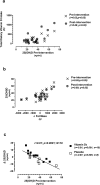Vitamin D supplementation and body composition changes in collegiate basketball players: a 12-week randomized control trial
- PMID: 35599918
- PMCID: PMC9116404
- DOI: 10.1080/15502783.2022.2046444
Vitamin D supplementation and body composition changes in collegiate basketball players: a 12-week randomized control trial
Abstract
Background: Vitamin D promotes bone and muscle growth in non-athletes, suggesting supplementation may be ergogenic in athletes. Our primary aim was to determine if modest Vitamin D supplementation augments favorable body composition changes (increased bone and lean mass and decreased fat mass) and performance in collegiate basketball players following 12 weeks of standardized training.
Methods: Members of a men's and women's NCAA D1 Basketball team were recruited. Volunteers were randomized to receive either a weekly 4000 IU Vitamin D3 supplement (D3) or placebo (P) over 12 weeks of standardized pre-season strength training. Pre- and post-measurements included 1) serum 25-hydroxy vitamin D (25(OH)D); 2) body composition variables (total body lean, fat, and bone mass) using dual-energy X-ray absorptiometry (DXA) scans and 3) vertical jump test to assess peak power output. Dietary intake was assessed using Food Frequency questionnaires. Main outcome measures included changes (∆: post-intervention minus pre-intervention) in 25(OH)D, body composition, and performance.
Results: Eighteen of the 23 players completed the trial (8 females/10 males). Eight received the placebo (20 ± 1 years; 3 females) while ten received Vitamin D3 (20 ± 2 years; 5 females). Weekly Vitamin D3 supplementation induced non-significant increases (∆) in 25(OH)D (2.6 ± 7.2 vs. -3.5 ± 5.3 ng/mL; p = 0.06), total body bone mineral content (BMC) (73.1 ± 62.5 vs. 84.1 ± 46.5 g; p = 0.68), and total body lean mass (2803.9 ± 1655.4 vs. 4474.5 ± 11,389.8 g; p = 0.03), plus a non-significant change in body fat (-0.5 ± 0.8 vs. -1.1 ± 1.2%; p = 0.19) (Vitamin D3 vs. placebo supplementation groups, respectively). Pre 25(OH)D correlated with both Δ total fat mass (g) (r = 0.65; p = 0.003) and Δ total body fat% (r = 0.56; p = 0.02). No differences were noted in peak power output ∆ between the D3 vs. P group (-127.4 ± 335.4 vs. 50.9 ± 9 W; NS). Participants in the D3 group ingested significantly fewer total calories (-526.2 ± 583.9 vs. -10.0 ± 400 kcals; p = 0.02) than participants in the P group.
Conclusions: Modest (~517 IU/day) Vitamin D3 supplementation did not enhance favorable changes in total body composition or performance, over 3 months of training, in collegiate basketball players. Weight training provides a robust training stimulus for bone and lean mass accrual, which likely predominates over isolated supplement use with adequate caloric intakes.
Keywords: 25-hydroxyvitamin D; basketball; body composition; sweat sodium.
© 2022 The Author(s). Published by Informa UK Limited, trading as Taylor & Francis Group.
Conflict of interest statement
Andy Blow is co-founder of the company, Precision, Fuel & Hydration Ltd.
Figures




Similar articles
-
Effect of high-dose cholecalciferol (vitamin D3) on bone and body composition in children and young adults with HIV infection: a randomized, double-blind, placebo-controlled trial.Osteoporos Int. 2017 Jan;28(1):201-209. doi: 10.1007/s00198-016-3826-x. Epub 2016 Nov 11. Osteoporos Int. 2017. PMID: 27837268 Clinical Trial.
-
The Effects of Cholecalciferol Supplementation on Vitamin D Status Among a Diverse Population of Collegiate Basketball Athletes: A Quasi-Experimental Trial.Nutrients. 2020 Jan 31;12(2):370. doi: 10.3390/nu12020370. Nutrients. 2020. PMID: 32023809 Free PMC article. Clinical Trial.
-
Influence of Vitamin D Supplementation on Growth, Body Composition, and Pubertal Development Among School-aged Children in an Area With a High Prevalence of Vitamin D Deficiency: A Randomized Clinical Trial.JAMA Pediatr. 2023 Jan 1;177(1):32-41. doi: 10.1001/jamapediatrics.2022.4581. JAMA Pediatr. 2023. PMID: 36441522 Free PMC article. Clinical Trial.
-
Effects of vitamin D3 supplementation on serum 25(OH)D concentration and strength in athletes: a systematic review and meta-analysis of randomized controlled trials.J Int Soc Sports Nutr. 2019 Nov 26;16(1):55. doi: 10.1186/s12970-019-0323-6. J Int Soc Sports Nutr. 2019. PMID: 31771586 Free PMC article.
-
Vitamin D in Basketball Players: Current Evidence and Future Directions.Sports Health. 2022 May-Jun;14(3):377-388. doi: 10.1177/19417381211019343. Epub 2021 Jun 4. Sports Health. 2022. PMID: 34085865 Free PMC article.
Cited by
-
Correlation between body composition and white matter hyperintensity in patients with acute ischemic stroke.Medicine (Baltimore). 2023 Dec 15;102(50):e36497. doi: 10.1097/MD.0000000000036497. Medicine (Baltimore). 2023. PMID: 38115357 Free PMC article.
-
Effects of Probiotics and Vitamin D3 Supplementation on Sports Performance Markers in Male Mixed Martial Arts Athletes: A Randomized Trial.Sports Med Open. 2023 May 16;9(1):31. doi: 10.1186/s40798-023-00576-6. Sports Med Open. 2023. PMID: 37193828 Free PMC article.
-
Energy and Macronutrients Intake in Indoor Sport Team Athletes: Systematic Review.Nutrients. 2022 Nov 10;14(22):4755. doi: 10.3390/nu14224755. Nutrients. 2022. PMID: 36432438 Free PMC article.
-
Current Aspects of Selected Factors to Modulate Brain Health and Sports Performance in Athletes.Nutrients. 2024 Jun 12;16(12):1842. doi: 10.3390/nu16121842. Nutrients. 2024. PMID: 38931198 Free PMC article. Review.
-
Effects of Vitamin D Supplementation in Elite Athletes: A Systematic Review.Orthop J Sports Med. 2024 Jan 3;12(1):23259671231220371. doi: 10.1177/23259671231220371. eCollection 2024 Jan. Orthop J Sports Med. 2024. PMID: 38188620 Free PMC article. Review.
References
-
- Cannell JJ, Hollis BW, Sorenson MB, et al. Athletic performance and vitamin D. Med Sci Sports Exerc. 2009;41(5):1102–1110. - PubMed
-
- Holick MF, Binkley NC, Bischoff-Ferrari HA, et al. Evaluation, treatment, and prevention of vitamin D deficiency: an endocrine society clinical practice guideline. J Clin Endocrinol Metab. 2011;96(7):1911–1930. - PubMed
-
- Allison RJ, Close GL, Farooq A, et al. Severely vitamin D-deficient athletes present smaller hearts than sufficient athletes. Eur J Prev Cardiol. 2015;22(4):535–542. - PubMed
-
- Hamilton B, Whiteley R, Farooq A, et al. Vitamin D concentration in 342 professional football players and association with lower limb isokinetic function. J Sci Med Sport. 2014;17(1):139–143. - PubMed
Publication types
MeSH terms
Substances
LinkOut - more resources
Full Text Sources
Miscellaneous
